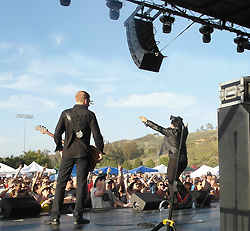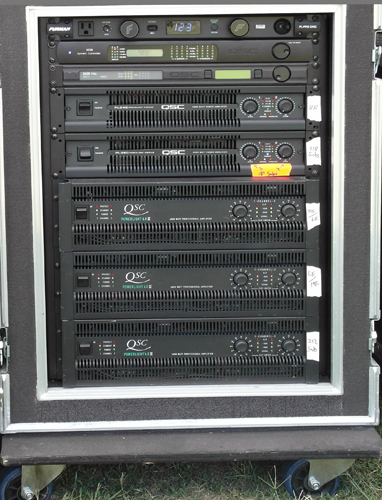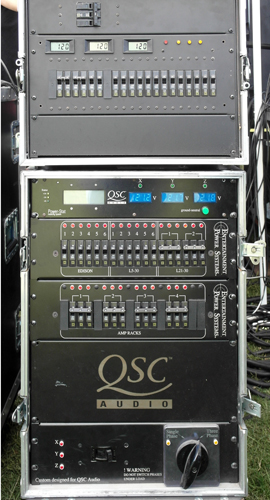
A portable generator supplied all AC power for the house and monitor systems.
DJE took a 3-phase Camlock from the generator to its power distribution rack that then fed clean, regulated power to all of the amp racks, in addition providing power to backline on stage.
Lighting power was provided on a separate generator.
Meeting Needs
Monitor mixer Martinez supplied 10 mixes for the stage from his Yamaha M7CL console located stage right, where he had a clear view of all the action.
Several mixes were sent to JBL SRX712M wedges along the front of the stage, as well as QSC KW153 full-range loudspeakers providing stage side-fills, more QSC K10 loudspeakers presenting auxiliary fill where needed, and a QSC KW181 sub and another K10 for drum fill.
All of the passive loudspeakers were also driven by QSC amplifiers, mostly PowerLight Series augmented by a few PLX Series units in the racks. Two dbx DriveRack DSP/controllers residing in the racks were used to apply all necessary stage wedge processing.
Martinez also accommodated artists who brought their own in-ear monitoring systems, with the M7CL console offering more than enough extra capability to meet this need.
DJE deployed one of its standard microphone lockers, mostly comprised of dynamic models. Vocalists were outfitted with Shure SM58s, guitar amp cabinets with Sennheiser e609s, Audix D2 and D4 on drum toms, SM57 on snare, Shure Beta 52 and SM91 on kick drum, and Shure KSM114 dual-pattern end-addressed condensers on overheads. DI boxes were available for those who preferred going direct.
Artists requesting use of their own microphones were generally discouraged, Cimino notes. “There are just so many preferences when it comes to mics. We simply, and patiently, explained to them that the system was all set and optimized, and changeover times were so short, that we couldn’t accommodate the change. Most of them were very understanding.”
It all goes back to what he sees as the biggest key to success in a multi-act event like Tributefest: communication combined with plenty of preparation.
“As a crew, we really do enjoy the challenge of making those 20-minute changeovers, and staying on schedule while delivering a high level of service to the artists and sonic quality to the audience,” he concludes.
“The client also likes it because they’re confident we’ve got things handled, so he doesn’t have to worry about it. He can be completely hands off and deal with other pressing issues.”


